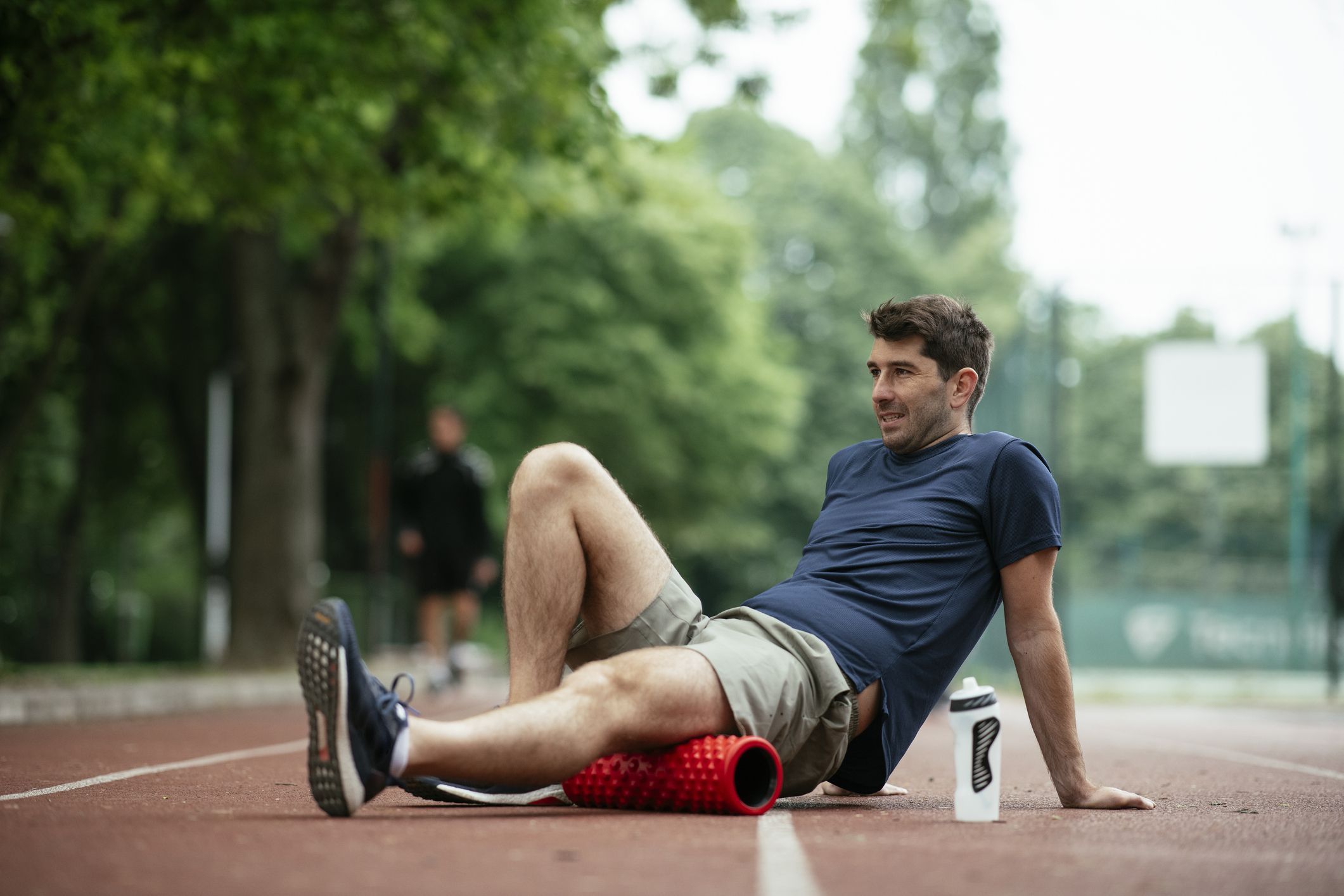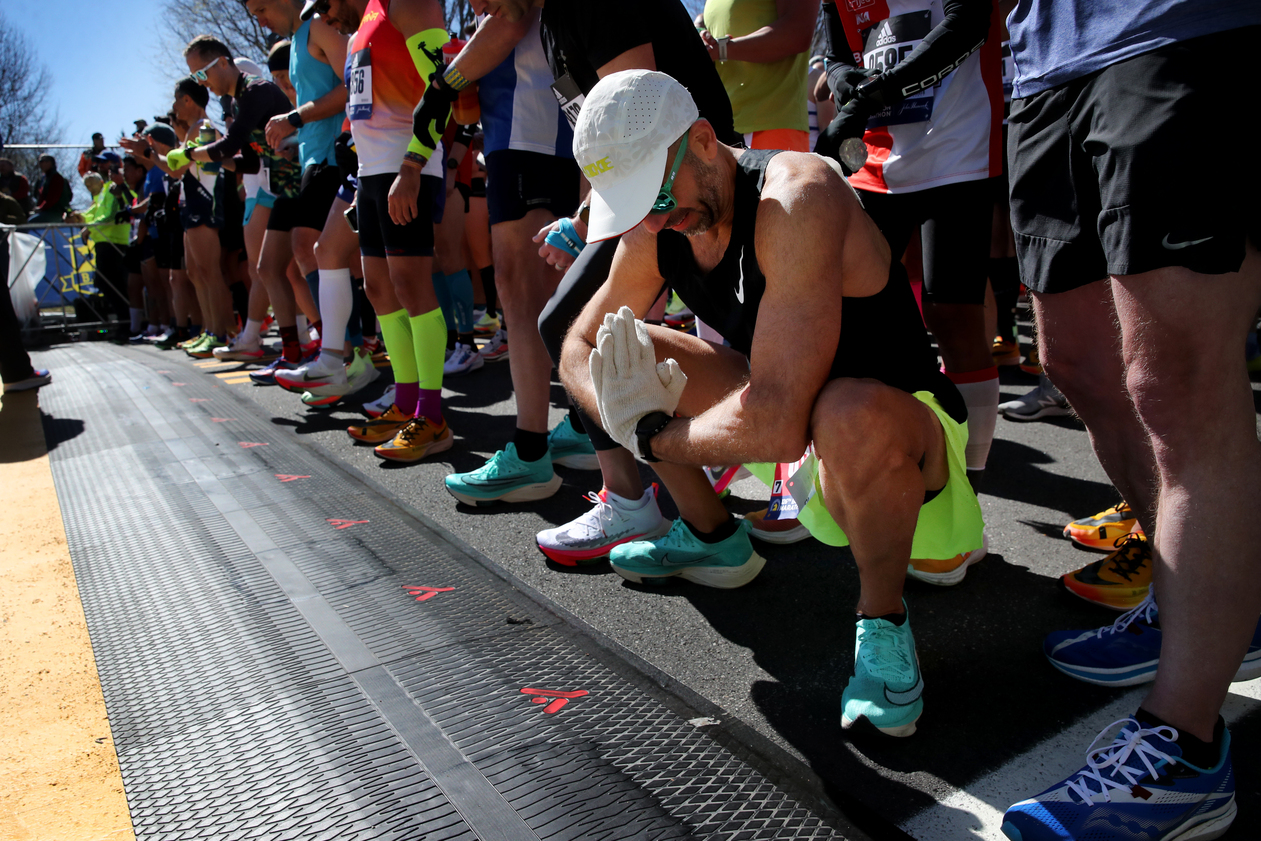

Featured
How To Improve Your Marathon Time
Modified: January 22, 2024
Discover the top tips and strategies to boost your marathon time in our featured guide. Enhance your training and achieve your personal best with expert advice.
Introduction
Running a marathon is a challenging and rewarding endeavor that requires dedication, preparation, and perseverance. Whether you’re a seasoned runner looking to set a new personal record or a beginner aiming to conquer your first marathon, improving your marathon time is a common goal among runners of all levels.
It’s important to approach marathon training with a well-defined plan in order to optimize your performance and reduce the risk of injury. By focusing on key aspects such as building endurance, incorporating speed and interval training, maintaining proper form, cross-training, and prioritizing rest and recovery, you can make significant strides in improving your marathon time.
In this article, we will discuss crucial strategies and tips to help you achieve your goal of improving your marathon time. Whether you’re aiming for a sub-four-hour marathon or simply looking to beat your previous time, these tips will set you on the path to success.
Before diving into the details, it’s important to note that improving your marathon time requires patience and consistency. Rome wasn’t built in a day, and a faster marathon time won’t be either. It’s a gradual process that requires gradual improvements in various areas of your training and overall lifestyle.
By maintaining a positive mindset, staying committed to your training plan, and implementing the strategies outlined in this article, you’ll be well on your way to crossing that finish line with an improved marathon time and a sense of accomplishment.
Setting a Goal
Before embarking on your marathon training journey, it’s crucial to establish a clear and realistic goal. Having a specific target in mind will help keep you motivated and focused throughout the training process.
When setting your goal, it’s important to consider factors such as your current fitness level, past marathon performances, and the amount of time you have to dedicate to training. Be honest with yourself and set a goal that challenges you but is also attainable.
One effective method of setting a goal is to use the SMART framework, which stands for specific, measurable, attainable, relevant, and time-bound. A good example of a SMART goal would be “I want to improve my marathon time by 10 minutes within the next six months by following a structured training plan and incorporating speed workouts.”
Having a specific and measurable goal allows you to track your progress and make adjustments to your training plan as needed. It’s also important to make sure your goal is relevant to your overall objectives and time-bound, meaning there is a clear deadline.
Additionally, consider breaking your main goal into smaller milestones along the way. For example, you can set intermediate goals such as completing a certain distance or improving your 10K time. These smaller achievements will provide a sense of accomplishment and keep you motivated as you work towards your ultimate goal of improving your marathon time.
Lastly, remember to celebrate your progress and achievements along the way. Recognize the hard work and dedication you put into your training, regardless of whether you reach your final time goal. The journey itself is a significant accomplishment, and every step forward is a step towards self-improvement.
Setting a goal not only gives you direction but also serves as a powerful motivational tool. It will provide you with the drive and determination to push through the challenges that may arise during your marathon training and ultimately help you achieve the desired improvement in your marathon time.
Developing a Training Plan
A well-structured training plan is the foundation for improving your marathon time. It ensures that you’re maximizing your time and efforts while minimizing the risk of injury. Here are some key steps to consider when developing your training plan:
1. Assess your current fitness level: Before diving into a training plan, it’s important to have a clear understanding of your current fitness level. This will help determine the appropriate starting point and progression for your training. Consider factors such as your running experience, average weekly mileage, and recent race performances.
2. Determine the duration of your training plan: The length of your training plan will depend on your current fitness level and the timeline of your goal marathon. Typically, training plans range from 12 to 20 weeks. It’s important to allow enough time for gradual improvement and sufficient rest and recovery.
3. Plan your weekly mileage: Your training plan should include a gradual increase in weekly mileage to build endurance. Begin with a comfortable base mileage and gradually increase it by around 10% each week. However, it’s important to listen to your body and adjust the mileage as needed to avoid overtraining.
4. Incorporate different types of runs: Variety is key in a training plan to improve your marathon time. Include long runs to build endurance, tempo runs to improve your lactate threshold, and speed workouts such as intervals or fartleks to enhance your speed and running economy. These different types of runs will help you develop the necessary physical and mental resilience for a faster marathon time.
5. Include rest days and cross-training: Rest days are just as important as your training days. They allow your body to recover and adapt to the physiological demands of marathon training. Additionally, include cross-training activities such as cycling, swimming, or strength training to improve overall fitness and reduce the risk of overuse injuries.
6. Gradually taper before race day: Tapering is a crucial component of any marathon training plan. It involves reducing your training volume and intensity in the weeks leading up to the race to allow your body to fully recover and perform at its best on race day. The duration of the taper period can vary, but it typically lasts around two to three weeks.
A well-developed training plan provides structure, progression, and variety to your marathon training. It ensures that you’re building the necessary endurance, speed, and strength while preventing burnout and injury. Remember, stick to the plan but also be flexible and listen to your body throughout the process.
Building Endurance
Endurance is a key component of marathon training. Building your endurance will allow you to maintain a steady pace for the duration of the race and prevent fatigue. Here are some strategies to help you improve your endurance:
1. Long Runs: Long runs are the backbone of endurance training. Gradually increase your long run distance each week to build the physical and mental stamina necessary for a marathon. Aim to complete your longest run a few weeks before the race, typically around 18-20 miles, to simulate the marathon distance.
2. Easy Runs: Incorporate easy runs into your training schedule. These runs should be at a comfortable pace and allow your body to recover from harder workouts while still maintaining an aerobic base. They help improve your cardiovascular efficiency and build endurance without adding excessive stress to your body.
3. Hill Training: Hill workouts are an excellent way to build endurance and strength. Find a challenging hill and incorporate hill repeats into your training. This will not only improve your cardiovascular fitness but also enhance your leg and core strength, making it easier to maintain a strong pace during the marathon.
4. Progression Runs: Progression runs involve starting at a slower pace and gradually increasing your speed over the course of the run. This training method helps improve your endurance and teaches you how to maintain a consistent pace as fatigue sets in. Begin with a comfortable pace and gradually pick up the speed, finishing strong at a faster pace.
5. Cross-Training: Engage in cross-training activities such as cycling, swimming, or elliptical workouts. These low-impact exercises provide cardiovascular conditioning without excessive stress on your joints and muscles. They can help improve your overall endurance while giving your body a break from the repetitive motion of running.
6. Consistency: Consistency is key to building endurance. Stick to your training schedule and make running a regular part of your routine. Regular training allows your body to adapt and improve gradually over time. Push yourself to be consistent, even on days when you don’t feel motivated, as these consistent efforts will build the foundation for improved endurance.
7. Mental Toughness: Endurance training is not just about physical strength but also mental toughness. Train your mind to stay focused and push through fatigue during your long runs. Develop mental strategies, such as positive self-talk or visualization, to help you maintain a strong pace and finish the race with determination.
Building endurance takes time, patience, and consistent effort. By incorporating these strategies into your training plan, you will be well on your way to improving your marathon time and crossing that finish line with confidence.
Speed and Interval Training
Speed and interval training are essential components of improving your marathon time. These workouts help improve your running efficiency, increase your lactate threshold, and enhance your overall speed. Here are some tips and strategies for incorporating speed and interval training into your marathon training plan:
1. Tempo Runs: Tempo runs are sustained efforts at a comfortably hard pace, just below your lactate threshold. These workouts improve your aerobic capacity and teach your body to maintain a faster pace for an extended period. Start with shorter tempo runs and gradually increase the duration and intensity over time.
2. Interval Training: Intervals involve alternating between periods of high-intensity running and recovery. These workouts improve your speed and anaerobic capacity. For example, you can run at a fast pace for 400 meters and then recover with a slow jog or walk for 200 meters. Repeat these intervals several times during your workout.
3. Fartlek Runs: Fartlek, which means “speed play” in Swedish, involves alternating between periods of faster and slower running. This type of training is less structured than traditional intervals but allows you to incorporate speed bursts throughout your run. During a fartlek run, choose landmarks or points where you increase your speed, and then recover with an easier pace.
4. Yasso 800s: Yasso 800s are a popular speed workout for marathon training. The concept involves running 800 meters at a specific target race pace, followed by an equal amount of recovery time. Repeat these intervals several times to build both speed and endurance. The time it takes you to complete the 800 meters can serve as an indicator of your marathon finishing time.
5. Hill Sprints: Hill sprints are short bursts of high-intensity running uphill. Find a steep hill and sprint up as fast as you can for around 10-15 seconds. Walk or jog back down for recovery, and repeat the sprint several times. Hill sprints improve your leg strength, power, and running economy, translating into better performance during the marathon.
6. Track Workouts: Utilize a local track for structured speed workouts. Perform repeats of specific distances, such as 400 meters or 800 meters, at a challenging but sustainable pace. Recovery between repeats should be a slow jog or walk. Track workouts allow you to accurately measure your pace and monitor improvements over time.
7. Incorporate Rest and Recovery: Speed and interval training can be intense and put stress on your body. Allow adequate time for rest and recovery between these workouts. This will prevent overtraining and help your body adapt to the training stimulus, ensuring optimal performance on race day.
When incorporating speed and interval training into your marathon training plan, it’s essential to start gradually, listen to your body, and gradually increase the intensity and duration of these workouts. Remember, the goal is to challenge yourself and improve your speed and running economy without risking injury or burnout.
Proper Running Form
Proper running form plays a crucial role in improving your marathon time and preventing injury. A good running form allows you to run more efficiently and with less wasted energy. Here are some essential tips to help you maintain proper running form:
1. Posture: Keep your posture upright and aligned. Avoid slouching or leaning too far forward or backward. Engage your core muscles to maintain a stable and balanced position.
2. Head Position: Keep your head aligned with your spine, looking forward. Avoid looking down at your feet, as this can strain your neck and disrupt your posture.
3. Arm Movement: Keep your arms relaxed and bent at about a 90-degree angle. Swing your arms back and forth in a straight line, avoiding excessive crossing over the midline of your body. The movement of your arms helps to drive the motion of your legs.
4. Stride Length: Aim for a natural and comfortable stride length. It’s better to have a slightly shorter stride that allows for quicker turnover of your legs rather than overstriding, which can lead to inefficient running and potential injuries.
5. Footstrike: Aim for a midfoot or forefoot strike rather than landing on your heel. This helps to absorb shock, distribute the impact forces more evenly, and allows for a quicker push-off. Avoid excessive pounding or heel striking, as this can lead to unnecessary stress on your joints.
6. Cadence: Aim for a higher cadence, which refers to the number of steps you take per minute. Increasing your cadence can help improve your running efficiency and decrease the amount of time your feet spend on the ground. Aiming for around 170-180 steps per minute is a good target.
7. Relaxation: Run with a relaxed and fluid motion. Avoid tensing up your muscles or clenching your fists. Focus on maintaining a smooth and efficient running rhythm that feels natural and comfortable.
8. Breathing: Pay attention to your breathing and try to establish a steady rhythm. Breathe deeply from your diaphragm, inhaling through your nose and exhaling through your mouth. This can help improve your oxygen intake and enhance your endurance.
9. Video Analysis: Consider utilizing video analysis tools or seeking the guidance of a running coach to assess your running form. They can identify any areas that need improvement and provide specific recommendations to help you optimize your form.
Improving and maintaining proper running form takes practice and conscious effort. Focus on one aspect at a time, gradually incorporating these tips into your training. With consistent practice, your running form will become more efficient, helping you run faster and reduce the risk of injuries.
Strength and Cross-Training
Strength and cross-training are vital components of improving your marathon time. They help build overall body strength, prevent muscle imbalances, and enhance your running performance. Here are some key strategies to incorporate strength and cross-training into your marathon training:
1. Strength Training: Include strength training exercises that target the major muscle groups involved in running, such as the legs, core, and glutes. Squats, lunges, deadlifts, and planks are excellent exercises to incorporate into your routine. Strength training helps improve running economy, increases power, and reduces the risk of injury. Aim for 2-3 strength training sessions per week.
2. Core Workouts: A strong core is essential for maintaining proper running form and stability. Include exercises that target the abdominal muscles, lower back, and hips, such as planks, Russian twists, and bridges. A stable core helps enhance your posture, balance, and overall running efficiency.
3. Yoga and Pilates: Yoga and Pilates are excellent forms of cross-training for runners. They help improve flexibility, balance, and body awareness. These practices can enhance your range of motion, reduce the risk of injury, and promote better recovery between training sessions. Consider incorporating a weekly yoga or Pilates class into your training schedule.
4. Cross-Training Activities: Engage in low-impact cross-training activities to complement your running. Cycling, swimming, rowing, or using an elliptical machine are great options that provide cardiovascular conditioning without the repetitive impact of running. Cross-training allows you to maintain fitness while giving your joints a break from the constant pounding of running.
5. Plyometrics: Plyometric exercises involve explosive movements that help improve power and speed. Exercises like box jumps, bounding, and skipping can boost your running performance by enhancing your leg strength and elastic energy storage. However, it’s important to gradually introduce plyometric exercises into your training to allow your body to adapt to the higher impact forces.
6. Balance and Stability Exercises: Incorporate exercises that improve balance and stability, such as single-leg squats or balancing on one leg. These exercises help correct any muscle imbalances and enhance your overall running efficiency. Better balance and stability contribute to a more efficient stride and reduce the risk of injury.
7. Recovery Exercises: Include recovery exercises as part of your training. Foam rolling, stretching, and using a massage ball can help reduce muscle soreness, increase flexibility, and improve recovery. These activities aid in flushing out metabolic waste products and promoting muscle relaxation.
Remember, strength and cross-training should be supplementary to your running workouts and not replace them. Aim for a balanced approach that allows for sufficient recovery and adaptation. By incorporating strength and cross-training into your marathon training plan, you’ll develop a stronger body, reduce the risk of injuries, and ultimately improve your marathon time.
Rest and Recovery
Rest and recovery are just as crucial as training when it comes to improving your marathon time. Giving your body time to repair and recharge is essential for optimal performance and injury prevention. Here are some key considerations for incorporating rest and recovery into your marathon training plan:
1. Rest Days: Schedule regular rest days throughout your training plan. These rest days allow your body to recover and adapt to the training stimulus. Rest days also help prevent overuse injuries and fatigue. Use these days to relax, engage in light activities, or focus on cross-training exercises that don’t put stress on your running muscles.
2. Active Recovery: On days designated as active recovery, engage in low-intensity activities that promote blood flow and aid in muscle recovery. This can include gentle walking, swimming, or cycling. Active recovery helps flush out metabolic waste products and promotes faster healing of muscle fibers.
3. Sleep: Prioritize quality sleep throughout your marathon training. Sleep plays a vital role in muscle recovery, hormone regulation, and overall well-being. Aim for 7-9 hours of uninterrupted sleep each night. Establish a relaxing bedtime routine and create a sleep-friendly environment to ensure optimal rest and recovery.
4. Nutrition: Proper nutrition is essential for rest and recovery. Fuel your body with a balanced diet that includes a mix of carbohydrates, proteins, and healthy fats. Adequate protein intake is important for muscle repair, and carbohydrates replenish glycogen stores in your muscles. Hydrate properly and prioritize nutrient-rich foods to support optimal recovery.
5. Massage and Foam Rolling: Consider incorporating self-massage techniques and foam rolling into your recovery routine. These practices help release tension, reduce muscle soreness, and improve flexibility. Focus on areas prone to tightness and trigger points, such as the calves, IT band, and glutes.
6. Listen to Your Body: Pay attention to any signs of excessive fatigue, persistent pain, or decreased performance. If you feel excessively tired or notice any unusual discomfort, it may be an indication that you need additional rest or recovery time. Don’t hesitate to adjust your training plan to allow for more rest and recovery if needed.
7. Tapering: Prioritize a proper tapering phase leading up to your marathon. Tapering involves reducing your training volume and intensity in the final weeks before the race. This allows your body to recover fully and peak on race day. Trust the tapering process and resist the temptation to do extra training during this period.
Remember, rest and recovery are not signs of weakness but essential components of a successful marathon training plan. By allowing your body the time it needs to heal and recharge, you’ll be able to perform at your best on race day and achieve your desired improvement in marathon time.
Nutrition and Hydration
Nutrition and hydration play a vital role in improving your marathon time. Proper fueling and hydration provide the energy and nutrients needed for optimal performance and endurance. Here are some key considerations for nutrition and hydration during your marathon training:
1. Balanced Diet: Maintain a balanced and varied diet to ensure you’re getting all the necessary nutrients. Include a mix of whole grains, lean proteins, fruits, vegetables, and healthy fats. Fuel your body with nutritious foods to support muscle repair, immune function, and overall well-being.
2. Carbohydrates: Carbohydrates are the primary source of fuel for endurance activities like marathon running. Prioritize complex carbohydrates such as whole grains, fruits, and vegetables, which provide sustained energy. Aim to consume carbohydrates before, during, and after long runs to replenish glycogen stores and support optimal performance.
3. Protein: Protein is essential for muscle repair and growth. Include lean sources of protein in your meals, such as poultry, fish, beans, and legumes. Consume a post-workout meal or snack containing protein to aid in recovery and muscle tissue repair.
4. Hydration: Proper hydration is crucial for optimal performance. Aim to drink water consistently throughout the day, not just during your runs. During training runs, carry a water bottle or plan your routes where you have access to water fountains. Listen to your body’s thirst cues and hydrate accordingly.
5. Electrolytes: Electrolytes, such as sodium, potassium, and magnesium, are essential for maintaining fluid balance and proper muscle function. Include electrolyte-rich foods in your diet, such as bananas, coconut water, and leafy green vegetables. Consider sports drinks or electrolyte supplements for longer runs to replenish electrolyte losses.
6. Pre-Run Fueling: Consume a balanced meal or snack containing carbohydrates and a small amount of protein before your long runs or race. This will provide the necessary energy to sustain your effort and prevent glycogen depletion. Experiment with different pre-run fueling options to find what works best for you.
7. Recovery Nutrition: After a long run or intense workout, prioritize post-run nutrition to aid in recovery. Consume a meal or snack containing a mix of carbohydrates and protein within 30-60 minutes of finishing your run. This will help replenish glycogen stores, repair muscles, and promote overall recovery.
8. Nutritional Timing: Pay attention to the timing of your meals and snacks. Fuel up adequately before long runs and workouts, and consume a balanced meal or snack within the post-run recovery window. Consistent and timely nutrition helps optimize energy levels and promote faster recovery.
9. Personalized Approach: Remember that nutrition and hydration needs can vary from one person to another. Experiment with different foods, fluids, and timing to find what works best for your body. Consider consulting a registered dietitian with experience in sports nutrition to create a personalized nutrition plan tailored to your needs.
Proper nutrition and hydration are critical for training progress, recovery, and overall performance. By focusing on fueling your body with the right foods and staying adequately hydrated, you’ll be better equipped to improve your marathon time and achieve your goals.
Mental Preparation
Mental preparation is as important as physical training when it comes to improving your marathon time. Cultivating a strong and positive mindset will help you overcome challenges, push through fatigue, and stay focused during the race. Here are some strategies to enhance your mental preparation:
1. Goal Visualization: Visualize yourself crossing the finish line with your desired time goal. Imagine the sensation of achievement and the emotions that come with it. Visualizing success can boost your confidence and motivation, making it easier to push through tough moments during the race.
2. Positive Affirmations: Use positive affirmations to reinforce belief in your abilities and stay motivated. Repeat phrases like, “I am strong,” “I can do this,” or “I am capable of achieving my goals.” This positive self-talk can help you overcome self-doubt and stay focused on your performance.
3. Mental Rehearsal: Practice mental rehearsals where you imagine yourself going through different phases of the race successfully. Visualize yourself handling challenging hills, maintaining a steady pace, and staying mentally strong throughout. Mental rehearsals help build confidence and prepare you for various scenarios.
4. Break the Race Down: Instead of focusing on the entire marathon distance, break it down into smaller, manageable segments. Focus on reaching each mile marker or even breaking down the race into sections. This approach helps prevent mental overwhelm and allows you to stay present and focused on the immediate goal.
5. Develop Mantras: Create short and powerful mantras that resonate with you. Repeat these mantras during challenging moments in the race to help you stay focused and motivated. Mantras like “I am strong and determined” or “I embrace the challenge” can be empowering and uplift your spirits.
6. Create a Race Strategy: Develop a race strategy ahead of time, including pacing strategies and goal targets for different parts of the race. Having a clear plan can provide structure and confidence during the race, helping you stay on track to achieve your desired time goal.
7. Stay Present: Focus on the present moment rather than worrying about what lies ahead or dwelling on past performance. Pay attention to your breathing, the rhythm of your steps, and the environment around you. Staying present helps keep you connected to your body and allows you to make necessary adjustments during the race.
8. Embrace Discomfort: Acknowledge that running a marathon involves discomfort. When facing physical or mental challenges, embrace the discomfort and see it as an opportunity for growth. By reframing discomfort as a normal part of the marathon experience, you can stay mentally strong and push through difficult moments.
9. Practice Mindfulness: Incorporate mindfulness practices into your training and daily life. Mindfulness can help improve focus, reduce anxiety, and enhance your overall mental well-being. Incorporate techniques such as deep breathing exercises or mindfulness meditation to cultivate a calm and focused mind.
Mental preparation is a key component of marathon training. By adopting these strategies and incorporating mental training into your routine, you’ll develop the mental resilience needed to push through challenges, stay focused, and achieve your best marathon time yet.
Injury Prevention
Injury prevention is vital when it comes to improving your marathon time. Being sidelined with an injury can hinder your progress and hinder your ability to train effectively. Here are some crucial strategies to help you prevent injuries during your marathon training:
1. Gradual Progression: Avoid sudden increases in mileage or intensity. Gradually build up your training volume and intensity to allow your body to adapt and avoid overuse injuries. Follow the 10% rule, which suggests increasing your weekly mileage by no more than 10% each week.
2. Proper Warm-up: Always begin your training sessions with a proper warm-up routine. Include dynamic stretches, gentle movements, and light jogging to warm up your muscles and prepare them for the upcoming run. This helps prevent muscle strains and improves flexibility.
3. Strength Training: Incorporate strength training exercises into your routine to build muscle strength and endurance. Strong muscles support your joints and help reduce the risk of overuse injuries. Focus on exercises that target the major muscle groups used in running, such as the legs, core, and hips.
4. Flexibility and Mobility: Incorporate regular stretching and mobility exercises into your routine. This helps improve muscle flexibility and joint range of motion, reducing the risk of muscle imbalances and strains. Consider activities such as yoga or Pilates to enhance overall flexibility.
5. Listen to Your Body: Pay attention to any signs of pain, discomfort, or fatigue. If you experience persistent pain or notice any unusual changes in your body, don’t ignore it. Rest or seek guidance from a healthcare professional if needed. Listening to your body and giving it the rest it needs can prevent minor issues from turning into major injuries.
6. Proper Footwear: Invest in a good pair of running shoes that provide proper support, cushioning, and stability. Replace your shoes regularly when they start to show signs of wear and tear. Wearing the right footwear can reduce the risk of overuse injuries and promote proper running mechanics.
7. Cross-Training: Engage in cross-training activities to vary the stress placed on your body. Incorporate low-impact activities like cycling, swimming, or elliptical training. This allows your running muscles to recover while still maintaining fitness and reducing the risk of overuse injuries.
8. Rest and Recovery: Prioritize rest and recovery days in your training plan. Rest days give your body time to repair, rebuild, and adapt to the demands of training. Allow for sufficient recovery between hard training sessions and don’t be afraid to take additional rest days if needed.
9. Proper Nutrition and Hydration: Proper nutrition and hydration support optimal muscle recovery and overall performance. Fuel your body with a balanced diet and stay hydrated before, during, and after your runs. Proper nutrition and hydration help support your body’s healing processes and reduce the risk of injuries.
Preventing injuries is crucial for consistent training and improvement in your marathon time. By incorporating these strategies into your training plan, you’ll reduce the risk of setbacks and maximize your chances of reaching your marathon goals injury-free.
Conclusion
Improving your marathon time is a challenging yet achievable goal. By implementing the strategies outlined in this article, you can make significant progress and cross that finish line with a sense of accomplishment and a faster marathon time.
Setting clear and realistic goals, developing a well-structured training plan, and focusing on key components such as building endurance, incorporating speed and interval training, maintaining proper running form, and incorporating strength and cross-training exercises are all key factors that can contribute to your success.
Additionally, don’t overlook the importance of rest and recovery, proper nutrition and hydration, mental preparation, and injury prevention. These elements play a significant role in optimizing your performance, preventing setbacks, and ensuring a successful marathon experience.
Remember, improving your marathon time is a journey that requires patience, dedication, and consistency. Celebrate the small milestones along the way and stay committed to your training plan. Stay focused on your goal, stay positive, and visualize success to keep yourself motivated.
Lastly, enjoy the process! Running a marathon is an incredible accomplishment, regardless of your finishing time. Embrace the training, the challenges, and the journey towards improvement. With determination, perseverance, and a well-rounded approach, you can achieve your goal of improving your marathon time and create a memorable experience that you can be proud of.









